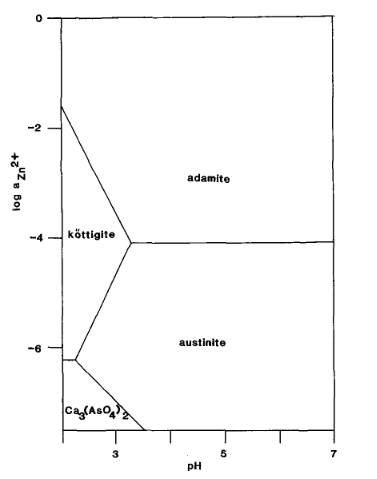Localities
At the Lilli mine, Lomitos, Bolivia, austinite is associated with calcite and chalcedony (Dana).
At Bou Azzer, Morocco, austinite is found in quartz and dolomite cavities associated with roselite, cobalt-rich talmessite and calcite ((Minrec 38.5.361).
Austinite from Bou Azzer - Image
At the Brown Monster mine, Inyo county, California, USA, austinite has been found coating fracture surfaces with mimetite. (Minrec 41.2.181)
At the type locality, Gold Hill Mine, Tooele County, Utah, USA, austinite occurs in the oxidised zone of a metal deposit, associated with quartz, limonite, adamite and talmessite (Mindat, HOM). It is closely associated with adamite, and it appears to be a later mineral, since groups of crystals of austinite have been found coating and growing on top of the adamite (AM 20.112-119).
Austinite from the Gold Hill Mine - Image
Alteration
The Activity-pH diagram below was calculated at 298.2 K for some zinc arsenates and Ca3(AsO4)2 for constant activity (roughly equivalent to concentration) of Ca2+ ions in solution, over a range of values of pH and of Zn2+ activity (MM 52.685).

The zinc mineral formulae are:
adamite: Zn2(AsO4)(OH)
köttigite: Zn3(AsO4)2.8H2O
austinite: CaZn(AsO4)(OH)
Back to Minerals